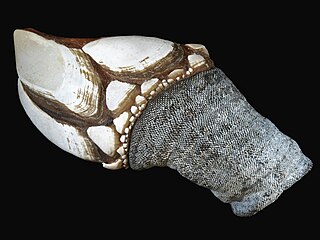
Barnacles are arthropods of the subclass Cirripedia in the subphylum Crustacea. They are related to crabs and lobsters, with similar nauplius larvae. Barnacles are exclusively marine invertebrates; many species live in shallow and tidal waters. Some 2,100 species have been described.

The barnacle goose is a species of goose that belongs to the genus Branta of black geese, which contains species with largely black plumage, distinguishing them from the grey Anser species. Despite its superficial similarity to the brant goose, genetic analysis has shown it is an eastern derivative of the cackling goose lineage.

Thoracica is an infraclass of crustaceans which contains the most familiar species of barnacles found on rocky coasts, such as Semibalanus balanoides and Chthamalus stellatus. They have six well-developed limbs, and may be either stalked or sessile. The carapace is heavily calcified. The group includes free-living and commensal species.

The cackling goose is a species of goose found in North America and East Asia.

Anelasma is a monotypic genus of goose barnacles that live as parasites on various shark hosts.

Pollicipes pollicipes, known as the goose neck barnacle, goose barnacle or leaf barnacle is a species of goose barnacle, also well known under the taxonomic synonym Pollicipes cornucopia. It is closely related to Pollicipes polymerus, a species with the same common names, but found on the Pacific coast of North America, and to Pollicipes elegans a species from the coast of Chile. It is found on rocky shores in the north-east Atlantic Ocean and is prized as a delicacy, especially in the Iberian Peninsula.

Dosima fascicularis, the buoy barnacle, is "the most specialised pleustonic goose barnacle" species. It hangs downwards from the water surface, held up by a float of its own construction, and is carried along by ocean currents.

Lottia digitalis, commonly known as the fingered limpet or ribbed limpet, is a species of sea snail, a true limpet, a marine gastropod mollusk in the family Lottiidae. These limpets are usually found on the surface of rocks in the high intertidal region on the coastal fringes of the north-eastern Pacific Ocean.

Lepas anserifera is a species of goose barnacle or stalked barnacle in the family Lepadidae. It lives attached to floating timber, ships' hulls and various sorts of flotsam.

Lepas anatifera, commonly known as the pelagic gooseneck barnacle or smooth gooseneck barnacle, is a species of barnacle in the family Lepadidae. These barnacles are found, often in large numbers, attached by their flexible stalks to floating timber, the hulls of ships, piers, pilings, seaweed, and various sorts of flotsam.

Pollicipes polymerus, commonly known as the gooseneck barnacle or leaf barnacle, is a species of stalked barnacle. It is found, often in great numbers, on rocky shores on the Pacific coasts of North America.

Catomerus is a monotypic genus of intertidal/shallow water acorn barnacle that is found in warm temperate waters of Australia. The genus and species is very easily identified by whorls of small plates surrounding the base of the primary shell wall; no other shoreline barnacle species in the Southern Hemisphere has that feature. This species is considered to be a relic, as these plates are found only in primitive living lineages of acorn barnacles or in older fossil species. The fact that this is an intertidal species is unusual, because living primitive relic species are often found in more isolated habitats such as deep ocean basins and abyssal hydrothermal vents.
Alepas pacifica is a species of goose barnacle in the family Heteralepadidae. It is a pelagic species and is an obligate associate of various species of jellyfish. It mainly occurs in the Pacific Ocean.
Oxynaspis gracilis is a species of goose barnacle in the family Oxynaspididae, commonly known as the black coral barnacle because it is normally found attached to black coral. The type specimen was found in Réunion in the East Indies.

Pollicipes caboverdensis is a species of goose barnacle in the family Pollicipedidae. It is found in rocky intertidal zones on the coasts of the islands Santiago, Sal and São Vicente, Cape Verde. The species was first described by Joana N. Fernandes, Teresa Cruz and Robert Van Syoc in 2010 after a 24.5 mm specimen collected from Ponta Preta, northwestern Santiago.

The clade Multicrustacea constitutes the largest superclass of crustaceans, containing approximately four-fifths of all described crustacean species, including crabs, lobsters, crayfish, shrimp, krill, prawns, woodlice, barnacles, copepods, amphipods, mantis shrimp and others. The largest branch of multicrustacea is the class Malacostraca.

Conchoderma virgatum is a species of goose barnacle in the family Lepadidae. It is a pelagic species found in open water in most of the world's oceans attached to drifting objects or marine organisms.

The barnacle goose myth is a widely-reported historical misconception about the breeding habits of the barnacle goose and brant goose. One version of the myth is that these geese emerge fully formed from goose barnacles (Cirripedia). Other myths exist about how the barnacle goose supposedly emerges and grows from matter other than bird eggs.

Lepas testudinata is a species of goose barnacle in the family Lepadidae. First observed in 1834, Lepas testudinata has undergone several reclassifications, and its relationship to other Lepas species is still the subject of ongoing research. L. testudinata is endemic to temperate waters in the China Seas, Australian Sea, and the Indo-West Pacific, and there are two distinct subgroups within the species. This barnacle species exclusively colonizes free-floating debris and tidewrack, and can form colonies of over 1000 members at a time. Due to this colonization habit, L. testudinata plays a role in biofouling and often serves as a foundation species when preyed upon.

Pollicipes elegans, the Pacific goose barnacle, is a species of gooseneck barnacle inhabiting the tropical coastline of the eastern Pacific Ocean. Its habitat borders a close relative, Pollicipes polymerus, a gooseneck barnacle covering the coastline of the Pacific Northwest. Other species belonging to the genus Pollicipes are found along the eastern coastlines of the Atlantic Ocean.






















